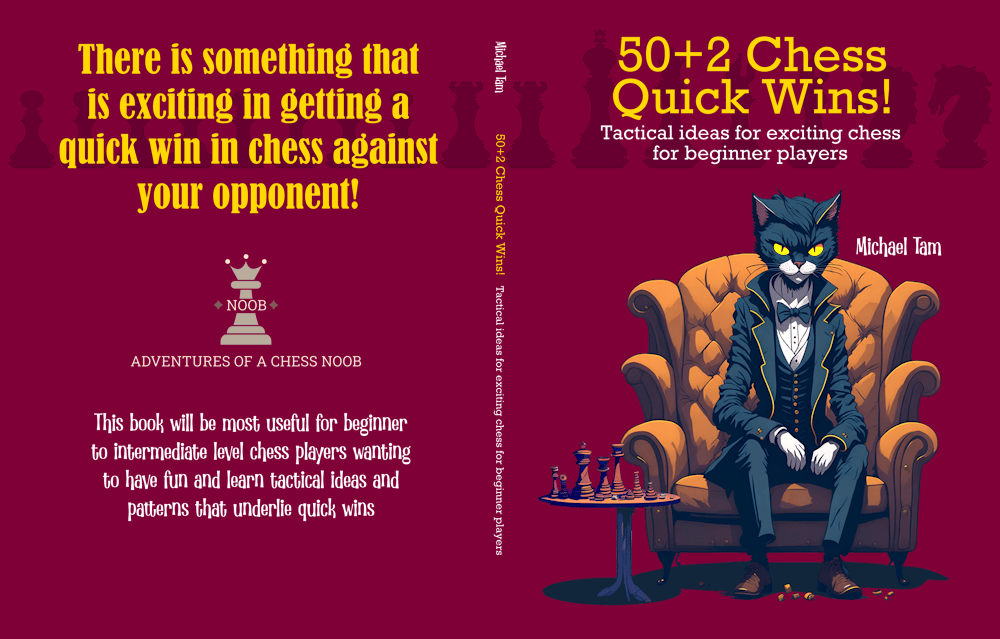
Modern Defense | Brilliant REVERSAL! 🤩
#modern #tactics #brilliant #rooksac
One of the most exciting aspects in a game of chess is when there is a reversal. This is especially the case when you manage to transform a losing position to one that is winning through a planned tricky manoeuvre!
This game was an Australian online tournament for players rated under 1500, where I played for New South Wales against Victoria. To set the context for those of you who aren’t Australians, there has been a long standing, mostly friendly (😏) rivalry between these two eastern states of Australia, particularly between their respective capital cities of Sydney and Melbourne. Although I don’t often enjoy daily games, I do like the occasional daily tournament games as the feel is different as there is stake of playing for your team.
In the tournament, I was matched against @Ceazelef, who is somewhat higher rated than me (1465 vs 1240 in daily).
Today, I’m going to cover the game where I played with the white pieces. Black led with the Modern Defense (1. e4 g6), one of the hypermodern openings. A curious thing with this opening is that despite its name, modern, it substantially predates the hypermodern movement and was known and played (uncommonly) a century before in the 19th century!
![]()
A historical note:
Those of you who follow my channel and blog might have already detected a pattern… Although hypermodernism started in the early 20th century in Europe, many of these ideas were part of the Indian chess tradition, and thus, appear in the extraordinary series of games played by “the Brahmin”, the very strong Indian chess player, Moheschunder Bannerjee against John Cochrane in Calcutta (Kolkata) in the 1850s. In these games we see the sophisticated use of openings for the first time in Western chess, including the entire class of Indian Defense, but also the Catalan Opening, and the Grünfeld Defense. Thematically, the Modern Defense was also played by Bannerjee, but in this case, it was already known to European chess players, but especially Cochrane…
This is as the first game of the Modern Defense in the massive LumbrasGigabase was also faced by John Cochrane a decade earlier in 1842. It was played by Pierre Charles Fournier de Saint-Amant (1800-1872), the strongest French chess master of the time, who was visiting London. Saint-Amant was in his prime, having only recently taken over as the master of the famous Parisian chess institution, the Café de la Régence, after the death of La Bourdonnais (possibly the strongest player in the world in the early 19th century) in 1840. Under modern computer-assisted analysis sensibilities, Saint-Amant with the Black pieces perhaps fumbled the opening, but Cochrane was nonetheless overwhelmed by the unorthodox play! Check out (Cochrane — Saint-Amant, 1842, London).

![]()
Historically, the chess battle between Saint-Amant and Cochrane’s protégé, Howard Staunton (1810-1874) is better known. In early 1843, Staunton lost a short match (2 ½ — 3 ½) against Saint-Amant who was again visiting London. Staunton challenged Saint-Amant to a longer match to be played in Paris in what some considered a de facto world championship challenge! In December 1843, Staunton prevailed winning (13 — 8) becoming the de facto World Champion; de facto because the title didn’t exist then. 😅 In this epic battle between England and France, Staunton prepared the opening line (1. c4), which after the match became known as the English Opening!

![]()
In our game, the opening was characterised with some positional shuffling, but I was happy with my move (7. d5), placing pressure on Black’s c6-knight. Stockfish evaluates that un-developing the knight (7… Nb8) was best for Black, but this is difficult to see and play. Instead, we had (7… Ne5), but then after (8. Nxe5 dxe5), Black’s fianchetto dark square bishop has their long diagonal blocked in by their own pawn on e5. This is not a disaster for Black, but reduces the usefulness, or perhaps, the “scariness” of that bishop!
However, the Modern Defense can be tricky to play against, as Cochrane also found. On move 9, I had a sense that I was ahead in the opening, but I also wasn’t sure what to play next. I played (9. Qd2?), thinking that developing my queen and forming a battery with the dark square bishop, and preparing for castling in either direction would be good. Stockfish, however, rated this a mistake [+0.7 → -1.1]. The reason is that after (9… Bxb5 10. Nxb5), my e4-pawn is hanging! Luckily for me, Black didn’t see it. 😏
I opposite-side castled (castled long) and at the beginning of the middlegame, found the right tactical idea with (12. h4). However, I then fumble this approach; I should have kept pushing the h-pawn to destabilise Black’s king’s defences! Instead, I lost tempo trying to rotate my knight into the attack, and then got myself tangled in knots against Black counterattack.
On turn 18, I undercalculated an exchange (18. Bxg4? Qxg4) and didn’t appreciate the looseness of my pawns against Black’s infiltrating queen [-3.1]. I managed to kick out Black’s queen but lose two pawns in the process. Black’s superior middlegame technique was on display and after (27… Qc4), forming mating threat with a battery of rook and queen on my c2-pawn, it crystalised in my mind that I was in serious trouble, and probably losing unless I do something drastic. We each had only three pieces left: queen and rook, and I had a knight for their dark square bishop. I needed to make a counterattack now while there were still some pieces left, or it would be an inexorable attrition to death.
Black played (28… Bh6), a powerful threat attacking my hanging e3-pawn, which if captured, would pin my d2-rook to the king. Stockfish recommends b3 in this position, which effective accepts that the game is lost and instead, aims to delay mate as long as possible. However, I saw a speculative and very tricky move that set up counterattacking resources – (29. Ng5!?)! This blocks Black’s bishop’s vision of the dark square diagonal, and pressures Black’s f7-pawn with a second attacker. The position also creates a scenario where Black can play a devastating blunder with (29… f6) as I would then follow up with (30. Qh7+) and Stockfish sees a [+M11]!
I suspect that this move was unexpected by Black, and my intuition was this move was probably “bad” according to the engine. It was [-2.7 → -4.1] and the simplest approach that Black could take would be to trade their bishop for my knight (29… Bxg5 30. hxg5), gaining on outside passed pawn and simply playing on. However, as we had numerical piece equality (3 pieces vs 3 pieces), my hunch was that they would attempt to preserve material. Loss aversion can be a strong cognitive bias – Black knew that they were winning positionally (but not materially) and thus, were likely to not consider moves involving material sacrifice. When one is already losing, playing tactics from a psychological perspective can give an edge!
My hunch was correct and rather than take the straightforward approach of simplification, Black opted to attack and chase my queen giving a brief shuffle (29… Rc7 30. Qb8+ Kg7). I doubled down on my tactical approach with another technically inaccurate but tricky move (31. Rf2!?), now bringing my rook onto the f-file, pressure Black’s f7-pawn. And here, with Black having already decided that their f-pawn was safe, they blunder not recognising the new threat! With (31… Qc5??), Black pinned my e3-pawn to my f2-rook, a move that tactically makes perfect sense. Except now with the brilliant (32. Rxf7+!!), I sacrifice the ROOK! The tactical manoeuvring worked with a REVERSAL in the game from [-5 → +2]. Black has a single legal move (32… Rxf7) and then (33. Ne6+!) a royal fork and I win Black’s queen! 🤩
The game quickly simplifies into an endgame with Black able to win my knight with a bishop fork. Moreover, Black’s rook and bishop synergise well, and I needed to play accurately to avoid mate on the back rank, or Black pinning my queen against my king. However, this was a daily game and I had plenty of time to calculate my endgame moves. In a queen vs bishop + rook endgame, the queen will overwhelm.
My opportunity arose about ten turns later with (45. Qa7+!) – my queen was able to force Black’s king into a position where I could give an absolute fork on the subsequent position. First the bishop (46. Qe3+!), then their a-pawn (50. Qa7+), and then finally (53. Qf4+) their final piece, the rook. With all hope extinguished, Black resigned, GG!
The big takeaway from this game is that when you are losing at the beginner-intermediate level, don’t be afraid to making speculative moves, especially if they help create complications and new tactical resources for a counterattack. Your opponent is more likely to blunder a reversal if you create the opportunities for them to blunder!



